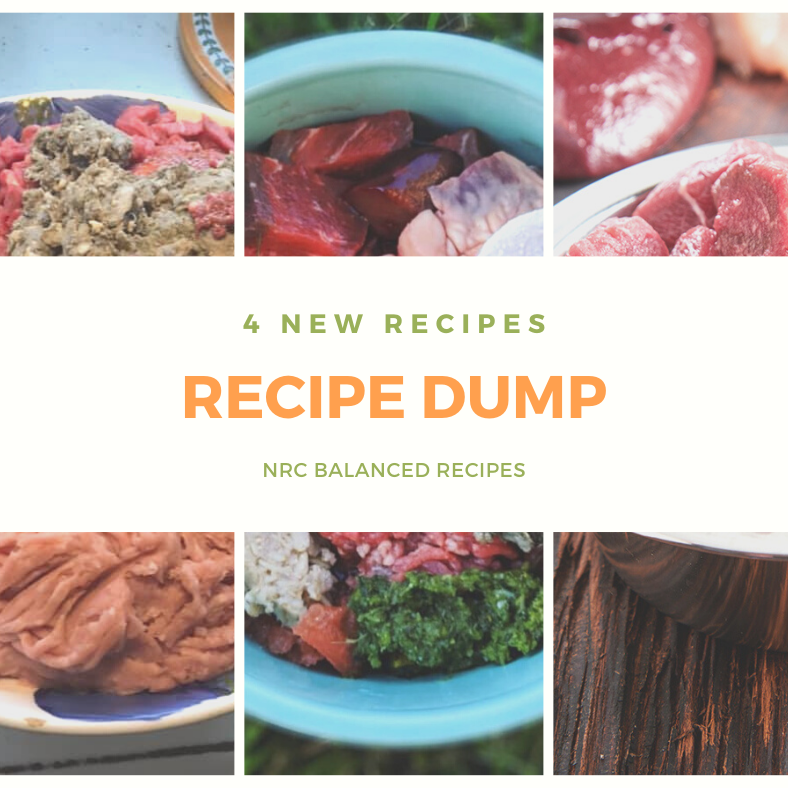Here are 4 homemade dog food recipes, balanced reflecting National Research Council guidelines, to get you started preparing the best homemade dog food recipes for your dog.
We've talked about the vitamins, minerals, and other nutrients that are all part of creating a balanced diet that meets NRC guidelines. Now it's time to put that knowledge to work with some recipes you can make at home to get and keep your dog healthy.
Why giving your dog real, homemade dog food matters
If you've been part of the community here on Dogly, you know we've talked about why homemade food is the strongest support you can give your dog to set up your pup to be healthy, now and for life. That's why certified canine nutritionists like me are so committed to taking the mystery out of knowing the food your dog needs and sharing that knowledge with pet parents.
Your Dog's Plan
Stop! Don't read this long article. Instead, get everything you need to know, including all advice on Recipes, in a customizable step-by-step plan for your dog created by our community of certified trainers and nutritionists.
How you're making your dog healthier by making homemade dog food...
How exactly is a homemade balanced diet often more optimal and precise for each dog? What your dog eats every day is the biggest point of personal control you have with the greatest potential impact on helping your dog to live long and live well.
More on homemade dog food
Homemade dog food allows you control over ingredient quality and precision nutrition. Actually, it's almost a misnomer to call it homemade "dog food," since of course it's for your dog, but now your dog's food will be really just food - real food, fresh food, the same food as human food (assuming you're also eating healthy meals!).
When you make your own dog food, you know exactly what's going into your dog's bowl - no more worrying about recalls or wondering about ingredients.
More on commercial dog food
Commercial dog food provides a broad and non-specific range of nutrients, and in most cases, with everything from ingredient choice (often ingredients you don't recognize and can't pronounce), to quality, sourcing, cooking process, and over-processed food leaving many of us as dog parents feeling uncertain about what we're feeding our dogs.
When you're no longer giving your dog traditional dog food...
Particularly when you're not feeding dry dog food/kibble, you may notice that food allergies or sensitivities your dog seemed to have to certain meats, etc. aren't an issue anymore.
When you're preparing clean, fresh dog food instead...
Your dog is no longer exposed to the mysterious fillers, chemical preservatives, and low-quality ingredients that can trigger sensitivities and make your dog's immune system vulnerable.
All dogs have different needs, and even if a recipe is meant for the same weight as your dog, other factors contribute to the appropriateness of the recipe (caloric density, fiber levels, cooked vs raw, etc). These recipes can be your foundation for fine-tuning homemade meals to fit any special considerations for your individual dog. (And if you have questions about a substitution you need to make in a recipe for your dog's needs, start creating your dog's nutrition plan and ask me!)
Recipes
Interested in Recipes? Follow topics you're interested in to customize your dog’s step-by-step plan so it's most helpful and tailored to your dog when you're ready to get started.
Thinking like a canine nutritionist when you prep your dog's food...
What do nutritionists take into consideration when it comes to actually preparing food for their dogs? Many things, but here are two key factors you'll want to keep in mind that can make all the difference as you jump in to prep DIY recipes for your dog:
Pro tip #1: know your good sources
One of the great benefits of home-prepared/home-cooked food is you do the sourcing, so you know what you're getting with each ingredient.
Source ingredients from vendors you trust and you'll know exactly what is going into your dog's diet and bowl. If you get to know your good, clean sources at the start as well as brands you or a nutrition resource trusts (for canned foods, supplements, vitamins, etc.), you're good to go in the future easily with confidence.
A few words about some key ingredients I often use that you'll be sourcing for my homemade dog food recipes and why...
High-quality protein: meats, fish, organs, eggs
Dogs are designed to consume high quality protein. My homemade dog food recipes are animal protein-based with meat and eggs as well as fish.
- Fresh Meats: Cooked & Raw. A great source for the high-quality protein and other essential nutrients all dogs need. Represented in these recipes with a range of animal proteins including some more rare meats to everyday favorites like ground beef and ground turkey.
- Organs: Cooked & Raw. Most dogs love organ meat. Organ meats are nutritionally dense, and like bones, they contain health-promoting compounds outside of the wealth of essential nutrients supporting your dog's health.
- Fish and Eggs: Cooked & Raw. Other nutrient-rich ingredients such as oily fish (salmon, sardines, oysters, etc., high in omega 3s) and eggs (raw eggs or hardboiled) which are often considered a near-perfect food and a complete protein are all key contributors to my balanced recipes. The egg shell (ground) can be used as well since the shell and membrane just inside contain important nutrients including natural anti-arthritics for joint health. You'll want to source local organic eggs that don't have the preservative sprays on the shells as supermarket eggs usually do.
High-antioxidant plant matter: fruits & vegetables
- Berries, kale, other greens, and plant-based superfoods: Cooked & Raw. Dogs are evolved to digest and assimilate nutrients from plant matter. Plant matter provides many benefits, including antioxidants and fiber. Some dogs, such as highly active working dogs, require extra support from carbohydrates.*
*Some health conditions also require higher carbohydrates.
All ingredient sources can be diversified according to your sourcing abilities and what is happily tolerated by your dog.
Home Cooking
Need more advice? Browse all guides in the Home Cooking Channel on topics like Recipes and Homecooking Basics - created by our community of certified experts for you and your dog.
Pro tip #2: prep for bioavailability (so your dog can access & use all the goodness)
You've brought together great quality ingredients with the right mix of nutrients for your dog. Now you want to be sure you're prepping them to be fully accessible for your dog's digestive system to put those nutrients to work.
Dogs' digestive systems are well attuned to processing most of your ingredients either as raw food or home cooked food.
The notable exception: fruits and vegetables
To be fully accessible for dogs' systems, plant ingredients' cell walls need to be broken up a bit. That means plant ingredients (fruits and vegetables) can be fed raw if blended well (except sweet potatoes) in a food processor or blender. Otherwise, they can be steamed or lightly cooked to make all the nutrients readily available for your dog's body to put to use.
Of course, healthy grains such as oatmeal and brown rice (included in the recipes) are served cooked.
The homemade dog food recipes
Each homemade dog food recipe is designed in amounts to be nutritionally balanced for adult healthy dogs. You'll find a recipe created for each of four different weights: 6 kg/13.2 lbs, 21 kg/46 lbs, 40 kg/88 lbs, and 58 kg/128 lbs.

Enjoy adding these recipes to your dog's diet!
Next up in the Home Cooking Channel on Dogly
Now that you have four homemade dog food recipes, learn more about the vitamins and nutrients that power homemade food in the step-by-step guide here.
Or hop over to the Home Cooking Channel if you'd like to ask a question in the Community discussion and start any of the other step-by-step guides in Home Cooking Basics or Recipes.
If you ever need more personalized nutrition guidance, please reach out!

